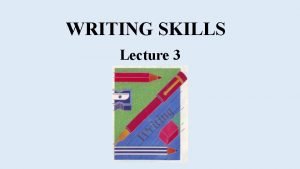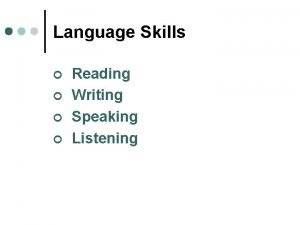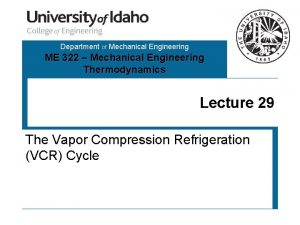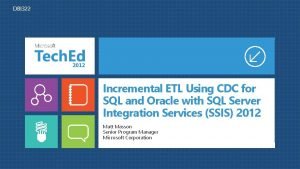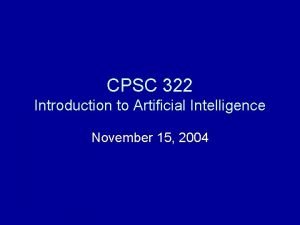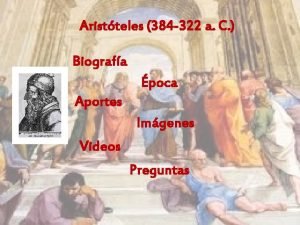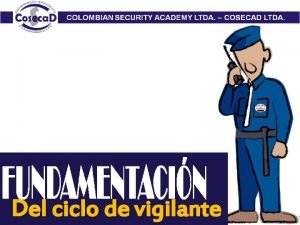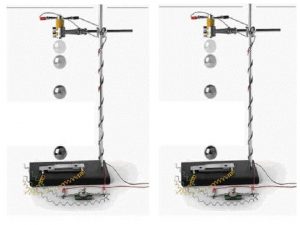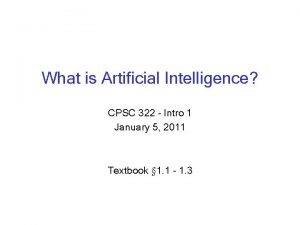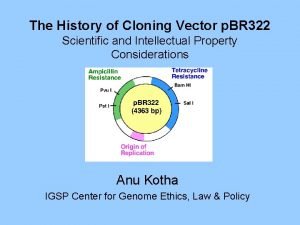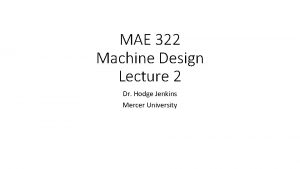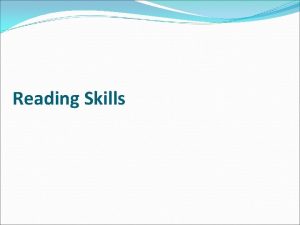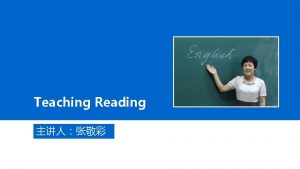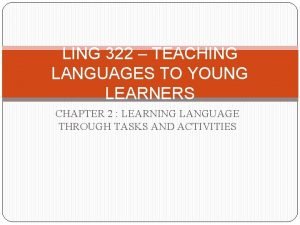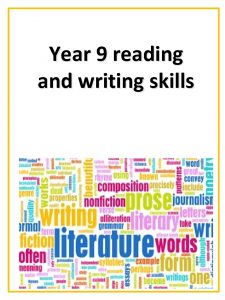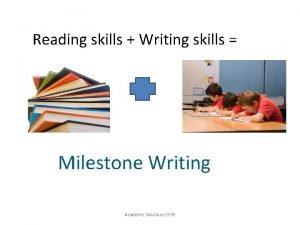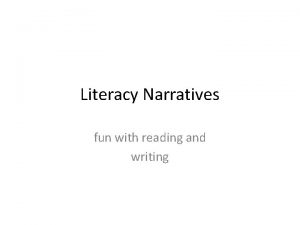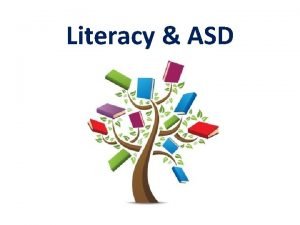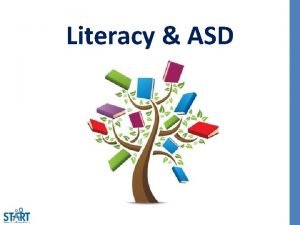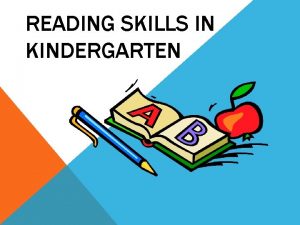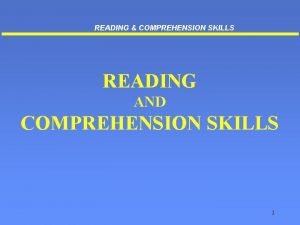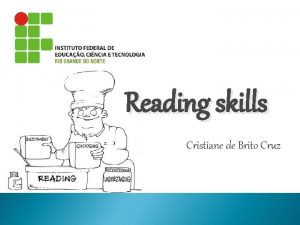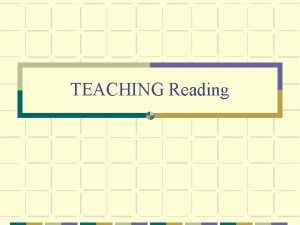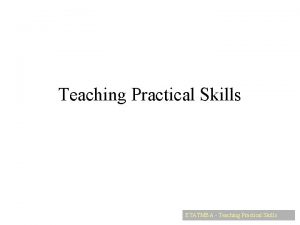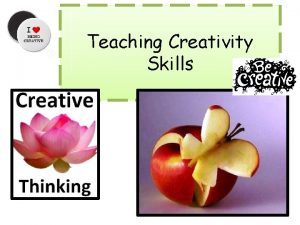LING 322 TEACHING LITERACY SKILLS READING WRITING WHAT


















- Slides: 18

LING 322 TEACHING LITERACY SKILLS – READING & WRITING

WHAT IS LITERACY? �The ability to read and write different texts for different purposes �Expressing and sharing meanings between people – social and cognitive �Skills and knowledge about how the written language operates when processing texts �Literacy event – story book reading, writing birthday cards, etc

READING A TEXT SEMANTIC INFO READI NG PHONOLOGIC AL INFO VISUAL INFO

READING IS … �LINKED TO SPEAKING – WRITTEN WORDS ARE DECODED INTO SPOKEN WORDS �BRINGS TOGETHER VISUAL INFORMATION – WRITTEN SYMBOLS, PHONOLOGICAL INFORMATION, SEMANTIC INFORMATION �PHONOLOGICAL INFO + VISUAL INFO + SEMANTIC INFO = UNDERSTANDING OF TEXT + SOCIAL USE OF THE TEXT

WRITING IS … �TURNING SPOKEN LANGUAGE INTO WRITTEN WORDS �MASTERY OF FINE MOTOR SKILLS TO FORM WRITTEN SHAPES, HOW WRITTEN SYMBOLS ARE COMBINED TO REPRESENT WORDS

PROBLEMS IN LITERACY �CONVENTIONS AND RULES IN THE USE OF WRITTEN FORMS �SPELLING AND PRONUNCIATION �SOCIAL CONTEXTS FOR USE �TEXT ORGANIZATION

WHAT DO SKILLED READERS DO? (pg 135) �Combine VISUAL, PHONOLOGICAL, SEMANTIC INFO �Build up an understanding of text – CONTEXT, TEXT ORGANIZATION, PARAGRAPH, SENTENCE/CLAUSE, WORDS, MORPHEMES, SYLLABLES, LETTERS

FACTORS AFFECTING READING AS A FOREIGN LANGUAGE �FIRST LANGUAGE EXPERIENCE �KNOWLEDGE OF THE FOREIGN LANGUAGE �AGE

FIRST LANGUAGE �Tuned into how L 1 works �Eg : fluent english reader needs to learn whole new Russian alphabet. In learning Arabic, FL learners have to learn the alphabet and also the direction of writing. �Transferability of knowledge, skills, and strategies depend on how the 2 languages work

FIRST LANGUAGE LEARNING EXPERIENCE �The way the child is taught to read in L 1 needs to be considered �When L 1 does not have a written form or when the medium of instruction is a foreign language – there will be no L 1 literacy

LEARNERS KNOWLEDGE OF FL �ORAL SKILLS �PHONOLOGICAL AWARENESS �VOCABULARY �PRONUNCIATIONS SKILLS

AGE �Youngest age (under 6) – master fine motor skills, joining shapes to form letters. Tracing names, or reading single words or simple sentences � 6 -9 years – can use similar methods with children for whom English is L 1 � 10 years – understand how written texts work, L 1 oracy and literacy are established, able to talk and think about differences between languages

READING AND WRITING IN ENGLISH AS FL �SET CLEAR AND BROAD APPROACH TO OBJECTIVES �CREATING A LITERATE ENVIRONMENT IN THE CLASSROOM �ACTIVE AND MULTI SENSORY EXPERIENCE �ROUTINES AND EVENTS IN THE CLASSROOM �FORMAL APPROACHES –EMERGENT LITERACY, LANGUAGE EXPERIENCE, WHOLE WORDS, PHONICS

FORMAL APPROACHES �EMERGENT LITERACY – L 1 phenomenon where children learn to read and write without any teaching, through exposure to text and reading �Works only with some children. A child needs lots of time individually with a skilled adult, plentiful supply of good books.

EMERGENT LITERACY � KEY FEATURES : 1. 2. 3. 4. 5. 6. 7. Children choose the books they want to read Children are motivated by choice Children often read the same book many times – a valuable learning experience Meaning comes first From meaning, attention moves to whole words, letter, initial consonants, final consonants, vowels Link between reading and oral skills is strong Parents can be involved

FORMAL APPROACHES � LANGUAGE EXPERIENCE – starts when children read and write at sentence level. Can be done as a whole class or individually. � KEY FEATURES : a. Child’s ideas are used to compose the reading text b. Child and teacher compose the sentence together c. Learning moves from meaningful idea-unit yo whole words and letters d. Words and meaning have physical reality e. Punctuation is present f. Integrates reading and writing

FORMAL APPROACHES �WHOLE WORDS APPROACH – starts from word level (the use of flash cards shown very quickly) to encourage rapid whole word recognition. Words shown are usually the most frequently used words �KEY FEATURES : 1. Practice at fast recognition 2. Good sense of achievement and motivation 3. Sight of vocab provide resource to help the child work out how letters combine into syllables

FORMAL APPROACHES �PHONICS TEACHING – letter sound relations. �Usually dry, boring, demotivating if done in isolation. �Can be integrated into story reading, class joint writing, sentence writing �PROGRESSION – ORDER OF CONSONANTS 1. b c d g h j m n p t w 2. f l r s 3. c g 4. v x y z
 Principles of teaching writing
Principles of teaching writing Pre reading while reading and post reading activities
Pre reading while reading and post reading activities Speaking listening reading writing
Speaking listening reading writing Media literacy and information literacy
Media literacy and information literacy 3 basic components of media and information literacy
3 basic components of media and information literacy What are the 6 characteristics of people media?
What are the 6 characteristics of people media? Cyber literacy and digital literacy
Cyber literacy and digital literacy Eee ankara
Eee ankara Me 322
Me 322 Ssis 322
Ssis 322 Cpsc 322
Cpsc 322 Biografia de aristóteles (384-322 a.c.)
Biografia de aristóteles (384-322 a.c.) Decreto 3222 de 2002 pdf
Decreto 3222 de 2002 pdf Fe 322
Fe 322 Aristote 384-322
Aristote 384-322 Cpsc 322: introduction to artificial intelligence
Cpsc 322: introduction to artificial intelligence Br 322
Br 322 Mae 322
Mae 322 Cpsc 322 ubc
Cpsc 322 ubc
